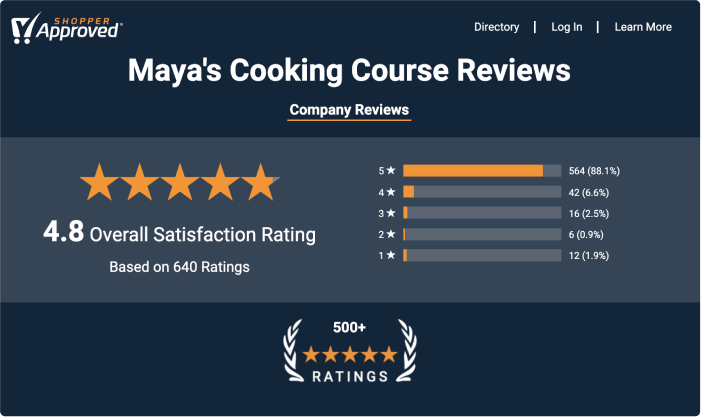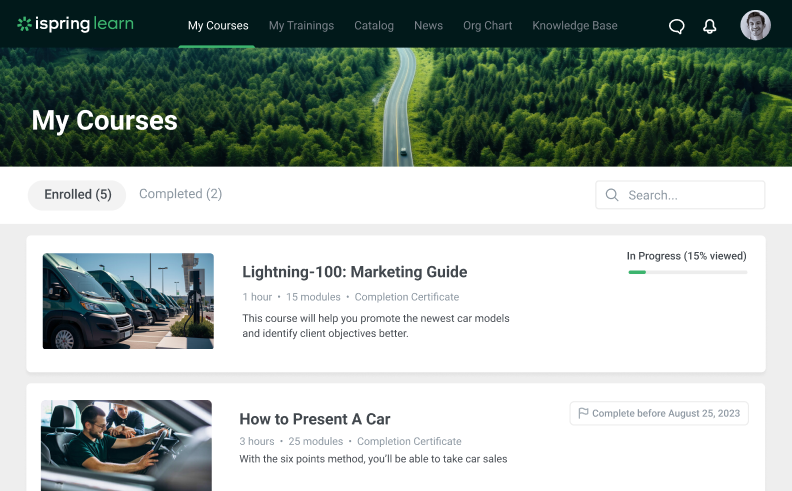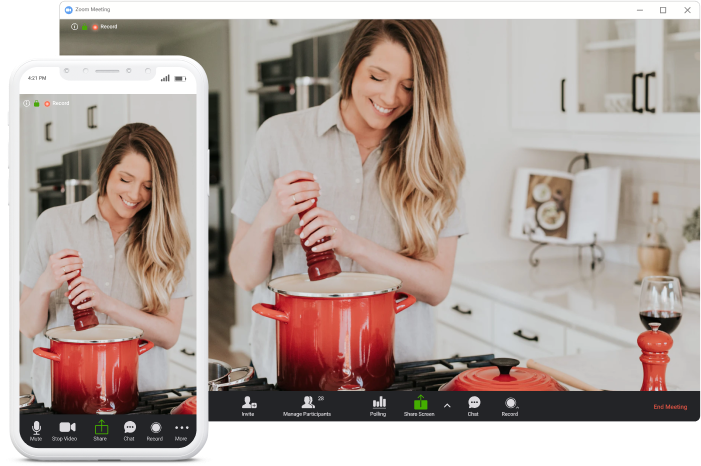25 Proven Ideas How to Market Online Course

Maya is an expert at cooking. She knows how to make a perfect cheddar cheese sauce, where to buy the freshest eggs, and why it is important to maintain the right temperature in the kitchen. Maya has created an online course about cooking and can’t wait to share her knowledge online.
The only problem is that Maya is an expert at cooking, not marketing. How can Maya promote her course on the Web? Where does she find the right audience? How can she double sales to get closer to her dream — to buy a little bakery in the city center?
In this article, we collected 25 easy and effective ways to promote an online course, even with no prior digital marketing experience.
How to Promote an Online Course Through SEO
First, put yourself into your clients’ shoes — where would you search for interesting and useful content? That’s right, on Google. That is why it is very important to inform Google what your course is about, what subjects it covers, and why it will be useful to people. It’s called SEO — search engine optimization. Here’s what you can do to attract more traffic from search engines.
1. Perform keyword research
Keywords are words and phrases that your potential buyers will type into search engines to find a course they need. Ask yourself what terms they would use to find your course. For example, Maya’s clients will probably search for “online cooking course” or “learn to cook online.”
Make a list of all possible keywords. If you have courses on different topics, group related keywords, for example, “handmade desserts” or “cooking a steak at home.” There are plenty of keyword research tools you can use, from Google’s Keyword Planner to specialized tools like SEMrush and Moz’s Keyword Explorer.
Once your list is ready, you can type the keywords into Google to see what kinds of sites appear in the results, whether sponsored ads appear, and if the term is highly competitive.
Tip: If you’re just getting started with SEO, it’s best to go for low competition keywords. They may have lower search volumes, but they allow you to rank higher on Google and get traffic relatively quickly.
2. Optimize course title, description, and meta tags
Now that you have collected and prioritized the keywords, make sure to include them in your course title and description to help search engines locate your content quickly.
If you sell courses on your own website, you can add keywords to the course page title, description, and even URL. Don’t forget about header tags (H1, H2, H3) that provide structure and context to your article.
Promoting an Online Course Through Advertising
Online advertising is one more way to reach and attract potential clients to your courses. With online advertising, you can show your ad only to the people who are interested in your course, excluding those who are not your target audience. Plus, you can fully control your expenses and easily track the effectiveness of your campaign.
3. Run your ad on Google Adwords
You can advertise your course on Google with Google Ads. Your offer will show up every time people search for keywords related to your topic. To start advertising, create a Google Adwords account, set your goals, location, and budget and create your ad message.
With Google Ads, you can not only advertise on Google Search, but also on different sites that are part of the Google Display Network. This ultimate guide to Google Ads will help you get started.
4. Buy banners
If you know what websites and blogs your target audience reads, try putting your ad banner there. Contact the owners of these sites to find out how much it will cost to display a banner there and if there are any technical or design requirements. Once you know the requirements, you can create a banner yourself, using online tools like Bannershark.
If you’re planning to place your banner on different sites, create a unique link or coupon code for each placement so you can track ad effectiveness.

Putting your banner on websites and blogs related to your topic can be very effective for online course promotion.
5. Use Facebook ads
Facebook ads offer multiple targeting options. You can show your ad to people with certain interests, demographics, and behaviors. To target audiences more precisely, research your existing clients. If you already have a considerable client base, Facebook allows you to build a Lookalike Audience of similar users.
Promoting a Course on Your Website
A website is your own space on the Internet where you can tell your story, share your expertise, and promote your business without any rules and limitations on content and design.
6. Create a website
Consider creating a website about your course business if you don’t have one yet. It doesn’t have to be a multi-page online store. Instead, create a simple landing page with a description of your business, experience, and available courses.
Add your contact information and links to your social networks. People will feel more comfortable buying your courses if they know more about you.
You can create a website yourself in an online website builder like Wix.
7. Start a blog
Your blog is not only a place to share your thoughts and expertise, but also a great tool for attracting free traffic from search engines. Remember the keyword research you did in the beginning? Now you can use those and similar keywords to put together an effective content plan for your blog.
Make a list of questions that your potential buyers ask Google and create an article for each relevant query. Mention your course every now and then in the articles and add a banner or a brief course description at the end of each post.
Using Social Proof to Promote Courses
New online courses appear every day. How do people know yours is good? One of the key factors that determine our behavior is social proof, a psychological concept that people follow the actions of other people. That’s why you need to show your potential buyers that the course has already proven useful for many people.
8. Post user reviews and testimonials
Ask learners who have completed your course to share their experience and feedback. Prepare a list of questions as an outline for a client to express their opinion. Here are a few you can ask:
- What did you like most about this course?
- What did you learn?
- What skills did you have a chance to practice?
- Who would you recommend this course to?
Post these reviews on the course page or add them to the course description on your course selling platform. Add links to reviewers’ profiles in social networks — this will add more value to each review.
9. Ask to leave a review on a review platform
Usually, people perceive reviews on a third-party review system to be more truthful and unbiased because product and service providers are not able to hide or change the reviews. Register on one of the review platforms, like ShopperApproved, and ask your clients to review your course.

Ask learners to leave a review on a third-party review system.
Be prepared for a negative review to appear. In order to support your reputation, find a way to handle negative customer reviews. React quickly, apologize and express empathy, and offer some form or compensation. If there was a mistake, explain the situation to clients delicately and politely. Make sure you use the feedback to improve the learning experience for all future students.
10. Create case studies and success stories
Use the power of stories to promote your course. Have a brief interview with the clients who absolutely loved your course or found it very useful. Look for inspiring stories and impressive results. As a result, you will be able to put together a great case study for your blog that will help attract more people who pursue the same results.
11. Build your customer base
From day one, make sure you don’t lose a single contact. You can collect all the clients’ details and email addresses in an Excel spreadsheet, or use more advanced tools. For example, some course selling platforms automatically collect buyers’ contact information. Later, you can use these details to offer your clients more courses or fine-tune your ad campaigns.
Promoting Courses Through Social Media
Social networks are perfect places to talk about your course in a relaxed and informal atmosphere. Proper promotion in social media can help you build credibility and attract the right audience free of charge.
12. Optimize your social networks
Start with your own social networks. You probably have a lot of friends on Facebook, Instagram, Twitter, and LinkedIn, but do they know about your course? Freshen up your social profiles. Add a link to your course in your bio and post content related to your work from time to time. For example, you can show some backstage processes in Instagram stories.

13. Create a Facebook group
Facebook is a great place to build a community. Create a group related to your sphere of work and post useful high-quality content from your blog or other resources. On Facebook, it is much easier to interact with your audience. You can create a poll, add a questionnaire for all new members, announce an event, and much more.
14. Promote on Instagram
Instagram is a social network with very high audience engagement. There are plenty of ways to promote your course there. You can create posts and stories, expand your reach with hashtags, connect with bloggers, go live, and launch ad campaigns. Just don’t forget to switch to a business profile to take advantage of all the cool features.
15. Post infographics on Pinterest
Pinterest is a visual social media, where you can post and share images, videos, and infographics. Create an infographic related to your course’s topic and share it online. Don’t forget to add a course link to your post to get traffic. Creating an infographic isn’t as difficult as it may sound. There are plenty of online tools, like Piktochart or Venngage where you can create infographics with no design skills.
Share Valuable Content to Promote Your Course
One way to promote your content is through other content. What kind of materials can you create to get people interested in buying your online course? Keep trying out different forms of content until you find your own success formula.
16. Create a sample course
Offer your potential clients a reduced version of your course to spark their interest. In this mini-course, make a brief intro to your topic and demonstrate all the cool things your course offers. For example, if you’re using interactive drag-and-drop assessments, make sure to demonstrate one of them in your sample course. At the end of the course, invite viewers to purchase the full version.
17. Publish your course in an online course marketplace
Selling courses in online course marketplaces has its pros and cons. Most online marketplaces offer limited customization and branding opportunities, impose their marketing and sales rules, and take considerable fees, not to mention very tough competition in all price tiers.
At the same time, they give you exposure to a huge base of potential buyers that can be targeted. While it may not be a great idea to sell all your courses on an online marketplace, you can get some of their traffic by publishing one of your courses there.
18. Offer a free knowledge check
How do people know they need your course? A quick test will help you reveal their knowledge gaps and entice them to learn more about your topic. Make the test challenging but not too difficult, unless you want to discourage your future learners. For each incorrect answer, add a feedback message with a link to your course.
19. Create learning paths
Creating one huge course with all the information related to your topic is probably not the best idea. Instead, you can create multiple short courses and put them into a step-by-step learning path. On your sales page, you can sell both the all-in-one learning path and individual courses.

In iSpring LMS, you can create individual courses, as well as learning paths, and sell them online.
Offer Promotions and Guarantees
When it comes to buying courses online, one concern clients may have is cost. Is this course a good deal? Does it provide enough value for the money? What if I don’t like it? Here’s what you can do to promote your course in this context.
20. Offer coupons
Coupons and discounts are a great way to attract new buyers and increase sales. Announce a limited-time sale or offer a discount coupon to every new customer. You can distribute discount coupons through social networks or send by email. Another option is to list your course on a coupon site, like Groupon. This will give you exposure to more potential clients.
21. Offer a satisfaction guarantee
All your customers have different levels of knowledge and different expectations. You can’t guarantee that everyone will love your course. But what you can guarantee is that you’ll provide a refund to everyone who is not satisfied with the course. In the education business, it is common to offer a 30-day money-back guarantee.
Add satisfaction guarantee information to your course description. People will feel more comfortable buying your course if they know they can get their money back.
Demonstrate Your Expertise to Promote the Course Online
People will be more willing to purchase a course from you if they are convinced that you’re an expert in your field. There are so many ways to build your online reputation. Try a few to find out what works best for your audience.
22. Start a YouTube channel
Most people on the web start exploring a new topic by browsing videos on YouTube. To take advantage of this traffic, start a branded YouTube channel and post useful videos, instructions, and reviews on a regular basis. Depending on your topic, you can record a screencast, create an animated video, or record a talking-head video using your smartphone camera. You don’t need fancy equipment or video editing skills to start.
23. Start a podcast
Podcast audiences on platforms like iTunes, Stitcher, and Google Play are huge and you have a great opportunity to share your expertise with all these people and get them interested in your course. In your podcast episodes, you can tell interesting stories from your field, invite experts, answer common questions or break myths — anything that your audience would find interesting. At the end of each episode, mention your course and how it relates to the topic you’ve been discussing.
24. Host a live webinar
Another way to grow your audience is by hosting a free webinar. Choose a hot topic everyone is interested in and prepare a short lecture with useful information and practical tips. At the beginning of the webinar, say a few words about yourself and your course. You might want to offer a discount coupon to those who stayed till the end.

25. Answer questions on Quora
Quora is a Q&A platform where everyone can post a question or share their knowledge with others. You can search for discussions relevant to your topic and provide detailed answers to show your expertise. No need to mention your course in every post — simply include a link to your course in your bio. If your answers are helpful enough, people will follow you and discover your work.
Conclusion
When it comes to promoting your course online, there’s no universal formula because every course is just so different in terms of topic, complexity, and target audience. These 25 ideas will serve as a good starting point, even if you have no experience with online marketing and design. If you have your own tried and tested marketing methods, please share them in the comments below.







